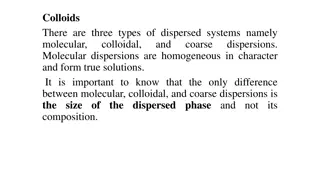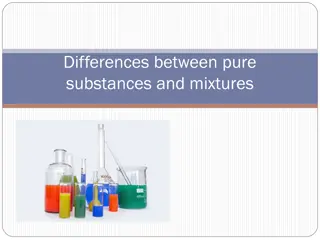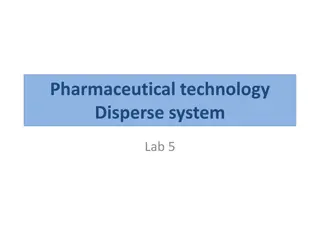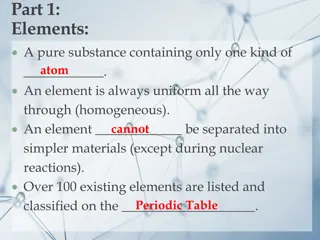Understanding Mixtures: Solutions, Colloidal Dispersions, and Suspensions
Food mixtures can be classified based on particle size distribution, with the dispersed phase scattered throughout a continuous medium. Solutions, a type of mixture, consist of a solute (dispersed phase) and a solvent (continuous phase), forming a homogenous blend. Factors like temperature, particle size, concentration, agitation, and vapor pressure influence solubility in solutions. Solids, liquids, and gases can form various solution types based on their states of matter. Temperature plays a crucial role in solubility, affecting how much solute a solvent can hold. The candy industry utilizes this principle to create sugar syrup solutions for various candies.
Download Presentation

Please find below an Image/Link to download the presentation.
The content on the website is provided AS IS for your information and personal use only. It may not be sold, licensed, or shared on other websites without obtaining consent from the author. Download presentation by click this link. If you encounter any issues during the download, it is possible that the publisher has removed the file from their server.
E N D
Presentation Transcript
Chapter 22 Mixtures: Solutions, Colloidal Dispersions, and Suspensions
Introduction Food mixtures are classified by size of particles distributed throughout the mixture. The dispersed phase refers to particles that are scattered throughout a medium. The medium in which particles are distributed is called the continuous phase.
Solutions A solution is a homogenous mixture of two or more substances. Solutions consist of two parts: the solute which is the dispersed phase, and the solvent, which is the continuous phase. The solute cannot be filtered or separated out of the solvent.
Solutions (continued) There are three states of matter, and solutions are possible in any combination of these three states. Most foods that are solutions exist as solids in liquids, liquids in liquids, and gases in liquids. A powdered drink mix when prepared is an example of a solid-in-liquid solution.
Solutions (continued) Most bottled flavorings, such as vanilla extract, are liquid-in-liquid solutions of alcohol in water plus flavoring compounds. Club soda is an example of a gas-in- liquid solution it is carbon dioxide gas dissolved in water.
Factors Affecting Solubility A number of factors can change how soluble one substance is in another: Temperature Particle size Concentration Agitation Vapor pressure
Solubility - Temperature The first factor that affects solubility of solids is the temperature of the solvent. As the temperature increases, the amount of a solid solute the solvent will hold increases. The type of solute will also affect how much can dissolve in a solution.
Solubility Temperature (cont.) This principle of temperature affecting solubility is used in the candy industry. The base of many candies is sugar syrups solutions of sugar in water. As water is heated, it can hold more sugar solute, and the concentration of the sugar syrup increases.
Solubility Temperature (cont.) The concentration of sugar syrup affects a candy s sweetness and texture. The temperature of the solvent also affects the solubility of gases. As the temperature of a solvent increases, the amount of gaseous solute it will hold decreases. This is why soft drinks lose their carbonation faster at room temperature than when chilled.
Solubility Temperature (cont.) The reason solvent temperature affects solubility of solids and gases is the increased number of molecular collisions. Increased temperature causes increased molecular movement. The more the molecules of solvent collide with molecules of a solid , the faster the solid will dissolve.
Particle Size The smaller the particles of solute are, the greater the exposed surface will be. The greater the surface area is, the faster the solute will dissolve. This is because solute molecules must come in contact with the solvent molecules to dissolve.
Concentration of a Solution Concentration is the measure of parts of one substance (the solute) to the known volume of another (the solvent). A solution holding all the solute that will dissolve in the solvent at a given temperature is saturated.
Concentration of a Solution Most food solutions are mixtures of polar compounds with water as the solvent. When water molecules come close to other polar molecules, hydrogen bonds will form. Once all the water molecules have bonded to a solute, a solution is at the saturation point.
Concentration of a Solution To form a supersaturated solution, a solution must be heated and then cooled. When solution is heated, it will be able to hold more solute. Then when the solution is cooled, it will have a higher concentration than would normally be possible at that temperature.
Agitation Agitation or stirring will speed the dissolving process until the saturation point is reached. Stirring also adds a small amount of energy that raises the temperature slightly.
Vapor Pressure This is the pressure at which gases escape from and dissolve into a liquid at the same rate. Small changes in pressure have little or no effect on the solubility of solids and liquids in solution.
Vapor Pressure The concentration of gas in a liquid is directly related to the pressure of the gas over the liquid. If you double the pressure over a gas-in-liquid solution, you can double the amount of gas in the solution. The fizz in carbonated drinks is caused by adding gas to liquid under pressure and then sealed in containers.
Vapor Pressure Within the sealed containers, the pressure is in equilibrium. This means the pressure of the gas over the liquid equals the pressure within the liquid. The liquid is neither gaining nor losing gas molecules. When seal on beverage is broken, the balance of pressure changes. The pressure above the solution decreases.
Measuring Solute Concentrations Mass percent is the percentage of the mass in a solution comes from the solute. Solutions are usually defined or described in terms of the mass percent of the solute. A 10% salt solution gets 10% of its mass from the dissolved salt.
Solute Concentration Affects Freezing and Boiling Points Water freezes at 0 C or 32 F and boils at 100 C or 212 F. When a solute, such as salt or sugar is added, the freezing point drops and the boiling point rises. The changes in the freezing and boiling points will be greater as the mass percent of the solute increases.
Solute Concentration Affects Freezing and Boiling Points When making ice cream, salt is added to the ice that surrounds the metal can containing the ice cream solution. The combination of salt and ice is endothermic. Endothermic means the mixture absorbs heat energy from its surroundings. As a result, the ice melts. The salt, ice and water has a lower freezing point than pure water.
Applications in the Beverage Industry Soft Drinks Carbonated soft drinks are solutions. Water is the solvent. Sweeteners, flavorings, coloring agents, acids, and CO2are the solutes. Artificial sweeteners do not give the solution the same body as sugar and corn syrups. Carbohydrate gums or pectins are added to diet drinks to copy the mouth feel of regularly sweetened beverages.
Applications in the Beverage Industry Soft Drinks (cont.) CO2 provides fizz to soft drinks as well as adding to the acidity. Acids act as flavor enhancers and preservatives. Citric acid is usually used for fruit flavored drinks and phosphoric acid is used more for non-fruit flavors such as colas and root beer. Additionally, sodium benzoate which converts to benzoic acid is usually added as a preservative.
Applications in the Beverage Industry Coffee and Tea Coffee and tea are considered nonnutritive beverages and are consumed for their flavors and stimulating effects. The roasting times, particle sizes, and added flavoring agents affect the strength and flavor. When brewed, brewing time and temperature will also affect strength and flavors.
Colloidal Dispersions Colloidal dispersions are mixtures in which microscopic particles of one substance is evenly distributed in another substance. The nature of the particles is what gives colloidal dispersions their unique characteristics. Three types of these mixtures are emulsions, foams, and gels.
Colloidal Dispersions - Characteristics True colloidal dispersions are made up of a continuous phase (medium that holds the dispersed particles)and a dispersed phase (particles or colloids). Colloids are macromolecules or clumps of smaller molecules. Starch and protein are examples of colloids that can be distributed in a colloidal dispersion.
Colloidal Dispersions Characteristics (cont.) Jelly, mayonnaise, butter, and gelatin are some foods that are colloidal dispersions. The key factor that distinguishes colloids from solutes is the size of the particles. Particle size of solutes in solutions is up to 1 nanometer (nm) in diameter.
Colloidal Dispersions Characteristics (cont.) Colloids are usually between 1 nm and 1 micrometer. (There are 1,000 micrometers to a millimeter and 1,000 nm to a micrometer.) Since colloids are larger, they can be dispersed in another substance, but they will not dissolve.
Colloidal Dispersions Characteristics (cont.) When light travels through a solution, no change in the direction of the light rays is noticeable. When light passes through a colloidal dispersion, the light rays scatter and are visible. This is called the Tyndall effect.
Factors that keep colloids dispersed Colloids remain dispersed due to two factors. The first is the motion of the molecules of the continuous phase. The second factor that keeps colloids dispersed is their electrical charges. The colloids are usually of the same substance.
Effects of particle density In some mixtures, the particles will not remain dispersed. This is due to the density of the particles in the dispersed phase compared to the density of the continuous phase. Examples include flour in water and fat in fresh milk that has not been homogenized.
Effects of particle density (cont.) If the particles are denser than the continuous phase, they will sink as the mixture sits. This is why so many sauces must be constantly stirred during the heating process. Example: Since starch granules are denser than the water in which they are dispersed, if the mixture is not stirred continuously, it will become lumpy and the starch will sink and burn to bottom of the pan.
Effects of particle density (cont.) Most colloids in foods are starches or proteins. Once the starch or protein molecules open their molecular structure, intermolecular bonds can form between the molecules. This creates a three-dimensional network. Water gets trapped between and around molecules.
Effects of particle density (cont.) Once starch molecules have swollen with water, they will stay dispersed, the mixture will thicken, and a colloidal dispersion is formed. When a thickened colloidal dispersion remains pourable, it is a sol. When pH, temperature, and / or concentrations are altered, the sol can be transformed into a rigid gel.
Effects of particle density (cont.) Gelatin is a protein-based colloidal gel. Jams and jellies are pectin-based colloidal gels. If particles of the dispersed phase are less dense than the continuous phase, they will rise to the top of the mixture. That is why a fat layer forms on the top of gravy the fat colloids are less dense than the rest of the gravy.
Milk as a colloidal dispersion Milk is an example of a colloidal dispersion. It is also a solution. Milk is made up of water, lactose, mineral salts, proteins, and fat. The lactose and mineral salts are solutes. They are dissolved in the water forming a solution.
Milk as a colloidal dispersion (cont.) The proteins are colloids. The milk fats are in suspension. The colloidal dispersion of the proteins in milk are stable. The fat globules in milk are not a stable dispersion.
Milk as a colloidal dispersion (cont.) Like fat in the gravy, the fat particles in fresh whole milk will rise to the top. When they rise to the top, they form a layer of cream. To keep the fat from separating to the top, milk is homogenized.
Milk as a colloidal dispersion (cont.) Homogenization is a mechanical process that forces milk through screens or small openings. This ruptures the membranes around the fat globules and breaks the globules into smaller particles. Homogenization alters the chemical nature of the fat particles keeping them from re-collecting and rising to the top.
Emulsions An emulsion is a mixture of two immiscible liquids, where one is dispersed in droplet form in the other. Immiscible liquids are liquids that will separate when combined. Usually one liquid is polar in nature, like water-based vinegar, and the other is nonpolar, like oil.
Emulsions (cont.) Example: bottle of oil and vinegar salad dressing. When you shake the bottle, the two liquids combine. As the bottle sets, the liquids separate, and the oil forms a layer on top of the vinegar. This type of dressing is a temporary emulsion.
Emulsions (cont.) Temporary emulsions are unstable mixtures of two immiscible liquids. In order for one immiscible liquid to stay dispersed in another a stabilizing factor must be added. This factor is called an emulsifier.
Emulsions (cont.) An emulsifier is a molecule that has a polar end and a nonpolar end. The polar end is attracted to and forms hydrogen bonds with other polar molecules. In the same way, the nonpolar end is attracted to nonpolar molecules.
Emulsions (cont.) Most emulsions require agitation, stirring, or beating for the emulsifier to bond to the molecules and stabilize the mixture. Example: lecithin is an emulsifier found in egg yolks. During beating, the lecithin in egg yolks will attach to the molecules of vinegar and oil to form mayonnaise.
Types of Emulsions The two most common types of emulsions are oil-in-water and water-in- oil. The dispersed phase, which is the liquid in droplet form, is listed first. The continuous phase is listed second. Usually, the phase present in the largest amount is the continuous phase.
Types of Emulsions (cont.) Examples of oil-in-water emulsions: Mayonnaise, salad dressings, ice cream, and cake batters. Examples of water-in-oil emulsions: Butter and margarine.
Factors affecting the stability of emulsions A factor affecting the stability of emulsions is temperature because fats and water have different thermal conductivity levels. Thermal conductivity is the ability to transfer heat energy. Water has more thermal conductivity than fat.
Factors affecting the stability of emulsions (cont.) This means water transfers heat more readily than fat. An oil-in-water emulsions will freeze at a higher temperature as well as faster than water-in-oil emulsion because heat begins transferring out of the continuous phase before transferring out of the dispersed phase.
Factors affecting the stability of emulsions (cont.) High temperatures as well as low temperatures can affect the stability of emulsions. This is especially true when the emulsifier is a protein. High temperatures cause proteins to coagulate which prevents the proteins from being evenly distributed through the mixture. The emulsion separates because the protein can no longer act as an emulsifier.
Factors affecting the stability of emulsions (cont.) Hollandaise sauce is an example of an emulsion that can easily become unstable and curdle due to high temperatures. Hollandaise sauce is made from a mixture of egg yolk, butter, lemon juice, water, salt, and cayenne pepper. The egg yolk serves as the emulsifier that keeps the butter dispersed.























